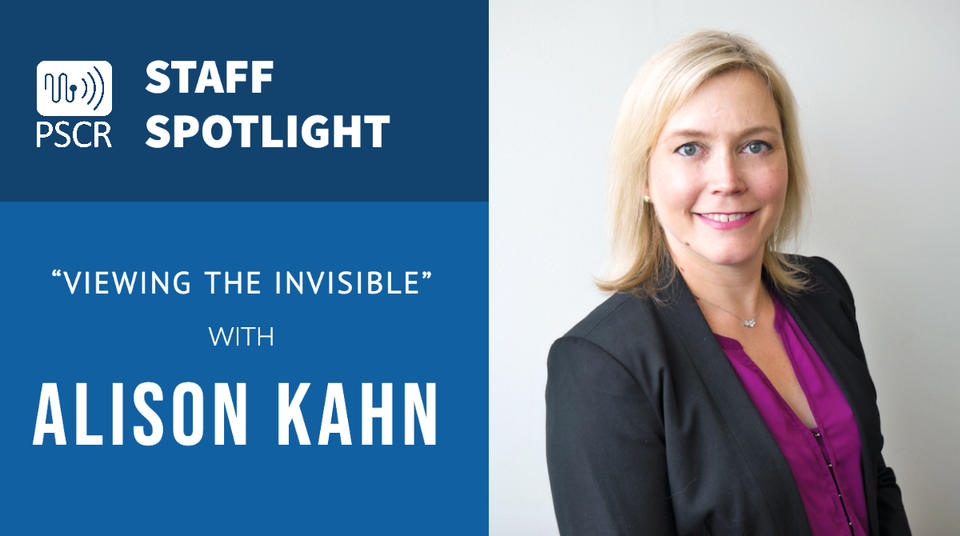
Alison Kahn is an Electronics Engineer with NIST's Public Safety Communications Research Division (PSCR) in Boulder, CO. In a predominantly male-dominated field, Kahn brings her diverse perspective to the division as a wife, a mother, an esteemed engineer, and a woman that's lived with Celerbal Palsy for years. She is currently the project lead for First Responder Personal Area Network research at PSCR, sponsored by the Department of Homeland Security Science and Technology directorate. At PSCR, Kahn's expertise informs PSCR's augmented reality (AR) research. The research aims to tackle the challenge of integrating numerous data streams from the IoT environment into practical AR implementations for public safety.
PSCR's communications team interviewed Kahn to gain insight into her unique position, and to learn more about her upcoming role in a South by Southwest (SXSW) panel about AR for Public Safety.
How did you get into your current role? Can you describe what compelled you to get into this type of work?
AK: I came to NIST from private sector telecommunications, working on interoperability testing between devices and the networks that support them. It is amazing to see how much happens for us to be able to utilize the devices that we have. When I came to PSCR and began exploring the complexity of the first responder environment, I realized that we (as private citizens) can take so much for granted in the way that we interface with devices. We can hold them; we can talk into them freely; we don't have to execute life or death missions while talking with a friend. The ability to explore the ways that we can bring today's technologies to first responders is very engaging.
What most excites you about Virtual Reality (VR) and Augmented Reality (AR) technologies?
AK: I love how they are disrupting every industry they touch. I saw a panel with a few of the AR players simply describing how their technology is changing the ability to train employees, find and retrieve information, and support remote locations. At the same time, it's going to totally change the way that we ingest and process information. When cell phones first came out, people could barely type out a text message. Now, people can type them out on virtual keyboards while walking on the street. What's the next level going to bring?
What do you find most challenging about applying VR and AR technologies to public safety?
AK:The inherent usability challenge of the first responder's mission is going to be tough to overcome. They need to be able to process information without it being overwhelming or distracting to the task at hand.
What problem do you think VR and AR technologies will solve in the public safety field?
AK: I believe that VR and AR technologies will give first responders the ability to view the invisible, whether that's their surroundings obscured by smoke, a suspect that is hidden within a building, or general information that relates to your surroundings. VR and AR will bring situational awareness to the first responder.
What do you wish others knew about VR, AR, and the public safety opportunity?
AK: I had the opportunity to participate in some Incident Commander training in 2019, to get a glimpse of what first responders need to communicate during an event. There is so much coordination that happens for those people to keep the public safe. To keep track of the numerous conversations, descriptions, and transmissions happening simultaneously is overwhelming, and first responders can do it. The ability for VR and AR to visualize some of those communications is going to be game-changing and life-saving.
What excites you about your upcoming panel at SXSW?
AK: I'm excited to see how the VR and AR industry can envision interfacing with the first responder industry and vice versa. PSCR is a bridge between these two groups, and I'm excited to hear ways that they have envisioned using these environments and any future technologies that may benefit first responders as well.
What do you hope people take away from your work with VR and AR technologies?
AK: I want people to understand the public safety experience. I think that is something we all look at it from the outside and think "Yeah, that's a tough job," but then we never truly think about the issues that make it "tough". It is extremely complex, and first responders have to constantly problem-solve, and innovate just to save people's lives (including their own). VR and AR provide the possibility for first responders to access a richer set of information, which could lead to great leaps in effectiveness and safety for everyone involved. I want people to experience these individuals that are working hard to keep their communities safe, and I want them to find ways to help.
Why should people come to your SXSW panel?
AK: This session shows a profession that exists to serve the public, and that has changed relatively little during recent times. It also shows cutting-edge technology and really drives the point home that VR and AR have so many more applications than just entertainment.
This talk will be delivered at PSCR 2020: The Digital Experience.

